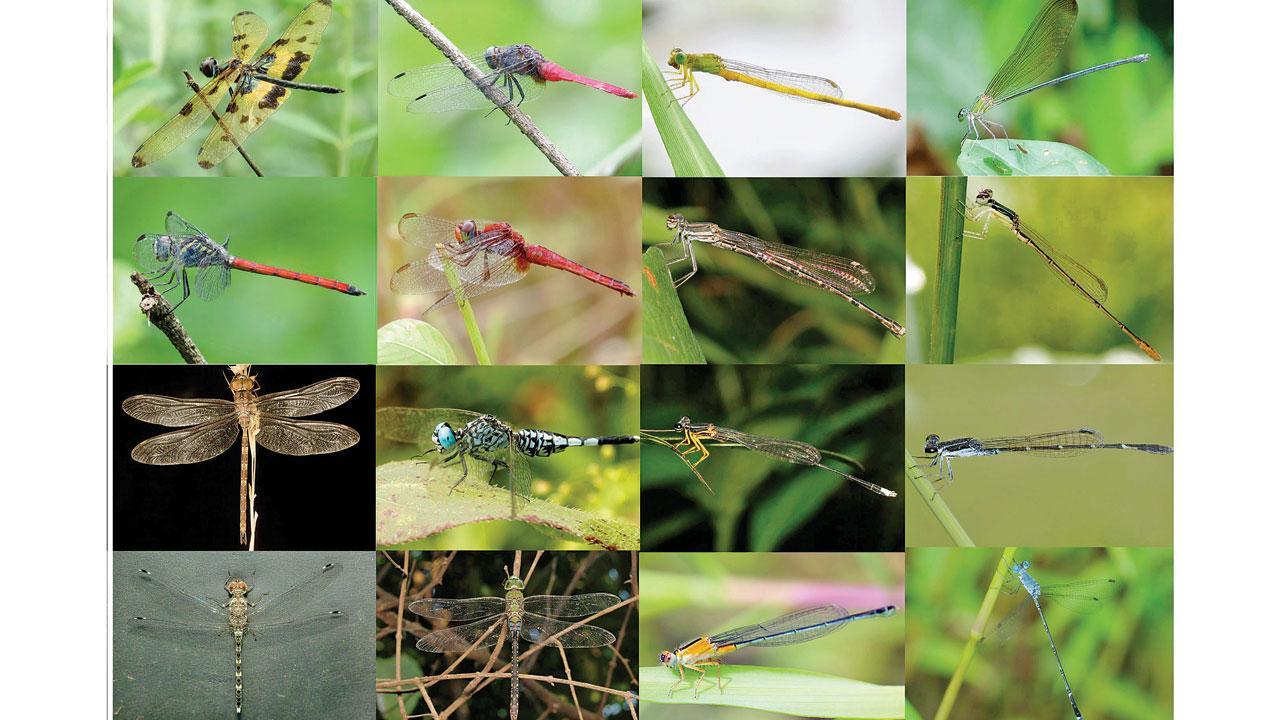Flying insects, which include dragonflies and damselflies, point to good water quality; researchers red-flag destruction of biodiverse area

Some of the odonate species documented by the researchers
A study carried out at Aarey Milk Colony (AMC) has yet again highlighted the rich biodiversity of the area. A recently published paper in the International Journal of Tropical Insect Science by researchers Dattaprasad Sawant and Rajesh Sanap has recorded 51 species of odonates, an order of flying insects that includes dragonflies and damselflies, from Aarey forest. Interestingly, 27 of them represent new records from the Mumbai Metropolitan Region.
ADVERTISEMENT
Sawant and Sanap conducted surveys in the colony to study odonates between July 2018 and December 2019. Dragonflies and damselflies are reliable indicators of the quality of freshwater habitats and rich odonate diversity indicates good water quality and a healthy pond ecosystem. Aarey Milk Colony harbours several seasonal wetlands, serving as an ideal habitat for dragonflies and damselflies. However, odonate diversity in AMC had been understudied.
Also read: Mumbai: Leopard attack in Aarey colony; one injured
Sanap said the colony is facing immense anthropogenic pressure, which may result in permanent destruction of some of the most important wetland habitats in Mumbai suburban district. “Forested areas, paddy fields, seasonal streams, grasslands and ponds were opportunistically surveyed. The lotus pond was the most frequently visited site. We recorded 51 species belonging to 32 genera in nine families of two suborders. Of these, 27 represent new records from the Mumbai Metropolitan Region,” he added.
The researchers have carried out photographic documentation of odonate species and have highlighted the thriving diversity of these insects in urban habitats. The findings will contribute to emphasising the ecological importance of AMC and aid its protection. Lead author of the research paper, Sawant, who is also a practising doctor at KEM Hospital, feels that despite having lush forests and numerous wetlands, Mumbai is understudied for odonates.
“AMC is an ideal habitat for odonates due to the forested area and lotus lake. This is the first attempt to document the odonata diversity of the colony. Previous research by the Zoological Survey of India showed less than 30 species in Sanjay Gandhi National Park. Our study added more 27 species to the Mumbai region’s odonata fauna. The corridor of Tungareshwar-SGNP forest may reveal more than 100 odonata species, including some rare ones,” Sawant said. Time and again, researchers have highlighted that these insects are important environmental indicators and rely on healthy aquatic ecosystems and healthy food chains. Threats to their well-being include habitat loss and water pollution.
Sanap told mid-day that recently the intensification of the anthropogenic load has become a severe threat to the poorly known fauna of this region. “Seasonal ponds constitute at-risk habitats due to their shallowness, ephemeral nature and small size, and this threat is expected to worsen in the near future. In this context, the lack of knowledge regarding the ecological significance of seasonal ponds and inadequate management may result in the deterioration or even disappearance of these unique habitats, which may in turn adversely affect the biodiversity in and around the ponds. Therefore, effective conservation strategies and management policies are imperative,” Sanap said.
However, the researchers’ findings can bridge the knowledge gap regarding insects from a threatened urban habitat, thereby contributing to its conservation. Notwithstanding, given the short duration and scope of this survey, additional systematic studies are warranted to gain insight into the overall odonata diversity in this region.
Aarey teems with life
AMC is home to 13 species of amphibians, 46 species of reptiles, 76 species of avifauna, 16 species of mammals, 86 species of butterflies, five species of scorpions, 19 families of spiders and 35 species of ants.
51
Total species of odonates recorded at Aarey forest
 Subscribe today by clicking the link and stay updated with the latest news!" Click here!
Subscribe today by clicking the link and stay updated with the latest news!" Click here!







